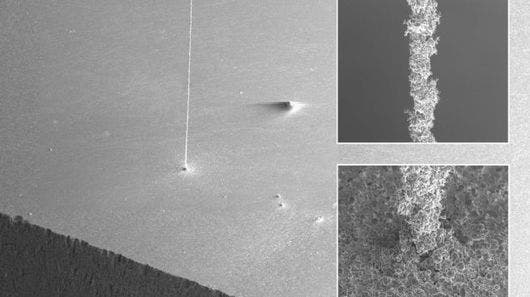A team from the University of Twente has developed a way to print 3D structures out of copper and gold, by using a pulsed laser to melt a thin film of metal and stacking the small droplets.

Image via: gizmag.com
The rapid development and huge potential of 3D printing has many hailing the field as the next “cornerstone of the manufacturing industry.” Currently, however, we are limited mostly to printing plastics. The development of a method that would allow for metals to be used would open up a huge range of new possibilities, as the robustness and good thermal and electrical conductivity of metals lend well to a number of fields, such as microelectronics. However, the high temperatures at which metals melt make the precise deposition of the molten material very challenging. Thermally resistant nozzles are also required to process the scalding material, but these aren’t readily available.
Now, researchers at the University of Twente made a major breakthrough in metal printing. They used a high intensity pulse laser to melt thin films of copper and gold into micrometer-sized flying droplets. These are then stacked in a controlled manner, and used to create three dimensional structures. It can be used to print virtually any shape. For example, they stacked thousands of the tiny drops to form micro-pillars 2 millimeters in height and 5 micrometers in diameter and went on to print vertical electrodes in a cavity, and lines of copper using the same device.

Image via: gizmag.com
During earlier attempts, the drops stayed spherical, and stacks of such drops were not very stable. The team used a surprisingly powerful laser compared to previous attempts, which improves velocity of the molten material. When the higher speed droplets hit the substrate, they deform and solidify into a tiny disk. This shape is essential for sturdy printing, as it allows researchers to firmly stack the droplets one on top of the other.
The article also studies how speed affects drop shape. The team previously predicted the speed intervals needed to achieve the desire shape for different materials and laser engines. As such, the results can be easily translated to other metals.
One problem they couldn’t overcome was that the high laser energy also makes droplets’ trajectories describe a cone, not a straight line, affecting the printing precision. The team aims to study the effect, to enable clean printing with materials such as metals, gels or extremely thick fluids.


